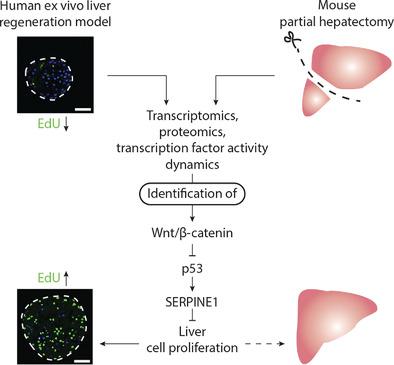Our official English website, www.x-mol.net, welcomes your
feedback! (Note: you will need to create a separate account there.)
A 3D Cell Culture Model Identifies Wnt/β-Catenin Mediated Inhibition of p53 as a Critical Step during Human Hepatocyte Regeneration.
Advanced Science ( IF 14.3 ) Pub Date : 2020-06-23 , DOI: 10.1002/advs.202000248 Nuria Oliva-Vilarnau 1 , Sabine U Vorrink 1 , Magnus Ingelman-Sundberg 1 , Volker M Lauschke 1
Advanced Science ( IF 14.3 ) Pub Date : 2020-06-23 , DOI: 10.1002/advs.202000248 Nuria Oliva-Vilarnau 1 , Sabine U Vorrink 1 , Magnus Ingelman-Sundberg 1 , Volker M Lauschke 1
Affiliation

|
The liver is a highly regenerative organ. While mature hepatocytes under homeostatic conditions are largely quiescent, upon injury, they rapidly enter the cell cycle to recover the damaged tissue. In rodents, a variety of injury models have provided important insights into the molecular underpinnings that govern the proliferative activation of quiescent hepatocytes. However, little is known about the molecular mechanisms of human hepatocyte regeneration and experimental methods to expand primary human hepatocytes (PHH). Here, a 3D spheroid model of PHH is established to study hepatocyte regeneration and integrative time‐lapse multi‐omics analyses show that upon isolation from the native liver PHH acquire a regenerative phenotype, as seen in vivo upon partial hepatectomy. However, proliferation is limited. By analyzing global promoter motif activities, it is predicted that activation of Wnt/β‐catenin and inhibition of p53 signaling are critical factors required for human hepatocyte proliferation. Functional validations reveal that activation of Wnt signaling through external cues alone is sufficient to inhibit p53 and its proliferative senescence‐inducing target PAI1 (SERPINE1) and drive proliferation of >50% of all PHH. A scalable 3D culture model is established to study the molecular and cellular biology of human hepatocyte regeneration. By using this model, an essential role of Wnt/β‐catenin signaling during human hepatocyte regeneration is identified.
中文翻译:

3D 细胞培养模型将 Wnt/β-连环蛋白介导的 p53 抑制确定为人肝细胞再生过程中的关键步骤。
肝脏是一个高度再生的器官。虽然稳态条件下的成熟肝细胞大部分处于静止状态,但在损伤后,它们会迅速进入细胞周期以恢复受损组织。在啮齿动物中,各种损伤模型为控制静止肝细胞增殖激活的分子基础提供了重要的见解。然而,人们对人肝细胞再生的分子机制和扩增原代人肝细胞(PHH)的实验方法知之甚少。在这里,建立了 PHH 的 3D 球体模型来研究肝细胞再生,综合延时多组学分析表明,从天然肝脏分离后,PHH 获得了再生表型,如部分肝切除时在体内看到的那样。然而,扩散是有限的。通过分析全局启动子基序活性,预测Wnt/ β -catenin的激活和p53信号的抑制是人肝细胞增殖所需的关键因素。功能验证表明,仅通过外部信号激活 Wnt 信号就足以抑制 p53 及其增殖性衰老诱导靶点 PAI1 (SERPINE1),并驱动所有 PHH 中超过 50% 的增殖。建立可扩展的 3D 培养模型来研究人类肝细胞再生的分子和细胞生物学。通过使用该模型,确定了 Wnt/ β -catenin 信号传导在人肝细胞再生过程中的重要作用。
更新日期:2020-08-05
中文翻译:

3D 细胞培养模型将 Wnt/β-连环蛋白介导的 p53 抑制确定为人肝细胞再生过程中的关键步骤。
肝脏是一个高度再生的器官。虽然稳态条件下的成熟肝细胞大部分处于静止状态,但在损伤后,它们会迅速进入细胞周期以恢复受损组织。在啮齿动物中,各种损伤模型为控制静止肝细胞增殖激活的分子基础提供了重要的见解。然而,人们对人肝细胞再生的分子机制和扩增原代人肝细胞(PHH)的实验方法知之甚少。在这里,建立了 PHH 的 3D 球体模型来研究肝细胞再生,综合延时多组学分析表明,从天然肝脏分离后,PHH 获得了再生表型,如部分肝切除时在体内看到的那样。然而,扩散是有限的。通过分析全局启动子基序活性,预测Wnt/ β -catenin的激活和p53信号的抑制是人肝细胞增殖所需的关键因素。功能验证表明,仅通过外部信号激活 Wnt 信号就足以抑制 p53 及其增殖性衰老诱导靶点 PAI1 (SERPINE1),并驱动所有 PHH 中超过 50% 的增殖。建立可扩展的 3D 培养模型来研究人类肝细胞再生的分子和细胞生物学。通过使用该模型,确定了 Wnt/ β -catenin 信号传导在人肝细胞再生过程中的重要作用。











































 京公网安备 11010802027423号
京公网安备 11010802027423号